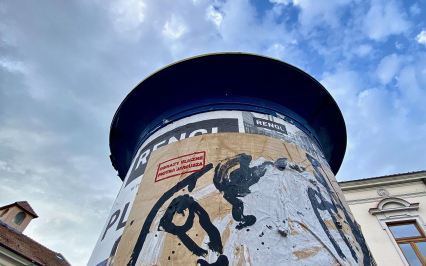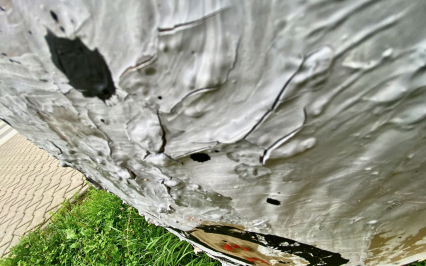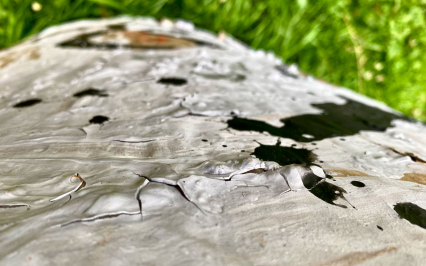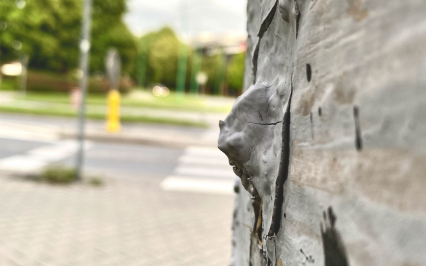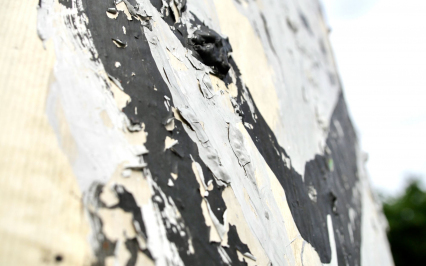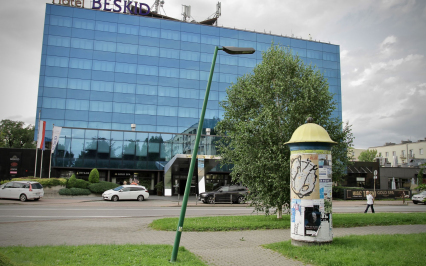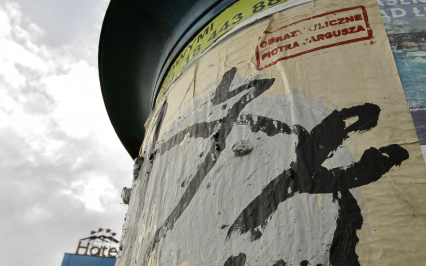Love is all the matters. Street paintings of Piotr Jargusz
24 May - 30 June 2024
Contemporary Art Gallery of
vernissage:
24 May 2024, hour 18:00
Exhibition of works by Piotr Jargusz, painter, associated with the Faculty of Art at the University of the National Education Commission in Krakow, where he runs the author's studios: painting and projects in social space.

Painting is an incredible medium. It has an incredible power of affecting and influencing our emotions. Painting which does not leave us indifferent to what it presents is able to form our thinking about its essence.
This is particularly true about the paintings of Piotr Jargusz. Using his hands, through which his creative energy – thoughts, feelings and sensitivity – flows, the artist leaves visible marks of his own definition of art. Nearly realistic or nearly abstract forms of his expression lead us through the meanders of his artistic path. In this way he shares with us his world and his perception of it. He is an extraordinary artist, possessing unique subtlety and mindfulness. His eyes penetrate everything he sees and analyze it with philosophical pensiveness and wisdom. He subjects particular elements of reality to in-depth analysis. He wants to understand the world he lives in and he paints it as he feels it. The art of Piotr Jargusz is created on
a staircase, his paintings are not created at the easel, paper lies on the floor, paint is applied directly from the tin with a brush, and quite often – with his bare hand. His works are painted directly with his hands, gaining sensuality, vividness and emotions. Sometimes his painting act seems to be clearly reserved, economical and harsh. There is not much color, sometimes we can see red, yellow or green. White and black, along with shades of grey, dominate his paintings. The artists paints a lot, and the rustling and delicate substance of paper emphasizes the fragility and transience of this art.
This is particularly true about the paintings of Piotr Jargusz. Using his hands, through which his creative energy – thoughts, feelings and sensitivity – flows, the artist leaves visible marks of his own definition of art. Nearly realistic or nearly abstract forms of his expression lead us through the meanders of his artistic path. In this way he shares with us his world and his perception of it. He is an extraordinary artist, possessing unique subtlety and mindfulness. His eyes penetrate everything he sees and analyze it with philosophical pensiveness and wisdom. He subjects particular elements of reality to in-depth analysis. He wants to understand the world he lives in and he paints it as he feels it. The art of Piotr Jargusz is created on
a staircase, his paintings are not created at the easel, paper lies on the floor, paint is applied directly from the tin with a brush, and quite often – with his bare hand. His works are painted directly with his hands, gaining sensuality, vividness and emotions. Sometimes his painting act seems to be clearly reserved, economical and harsh. There is not much color, sometimes we can see red, yellow or green. White and black, along with shades of grey, dominate his paintings. The artists paints a lot, and the rustling and delicate substance of paper emphasizes the fragility and transience of this art.
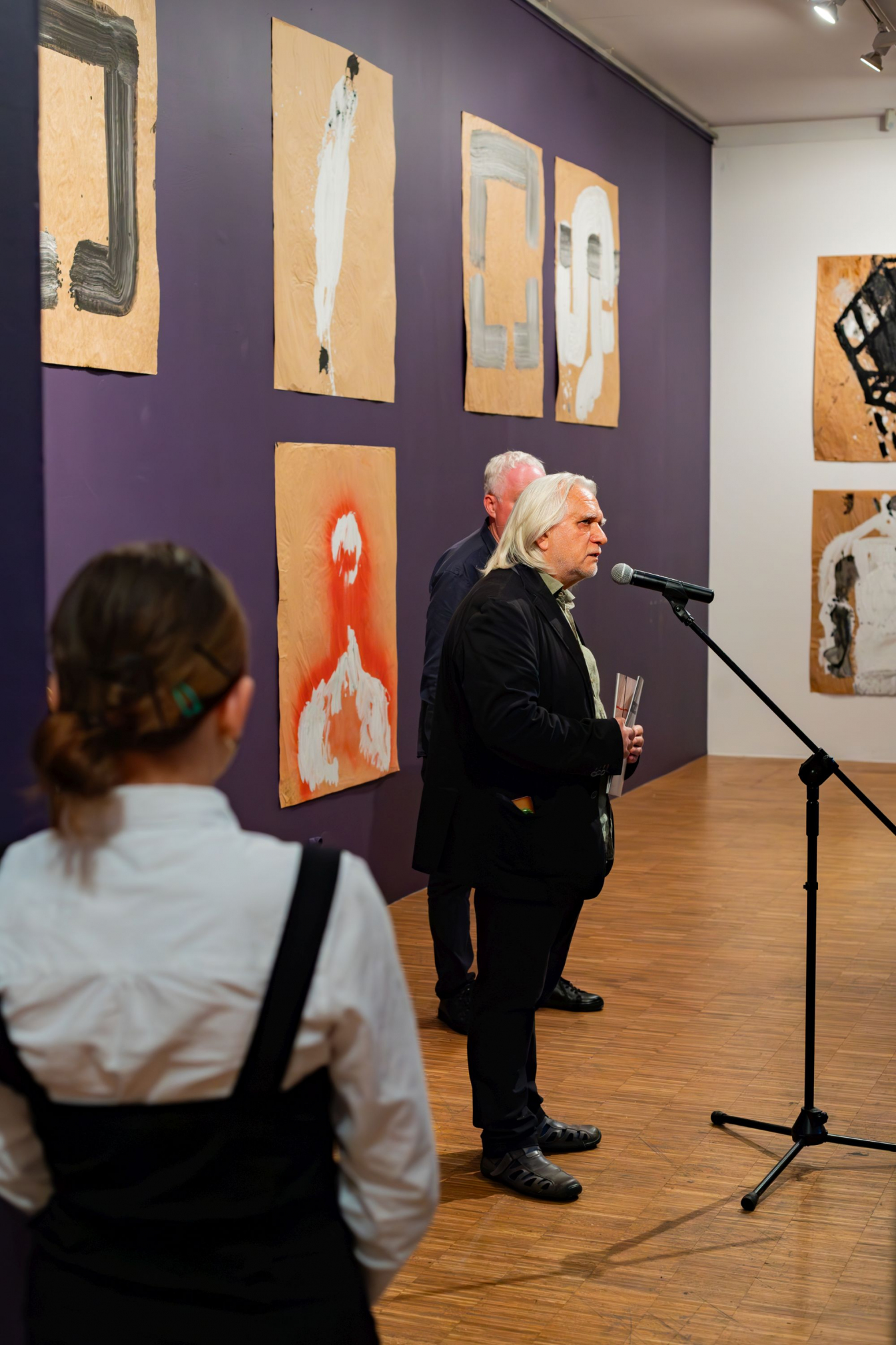
The artist took his art to the street. We no longer have to visit an art gallery, museum or another closed exhibition area to meet his painting. He comes to us with his art, faces is and surrounds us with his works. He covers poster pillars with his paintings. Standing out from advertisements, they are an exceptional and intriguing phenomenon, so unusual in everyday street hustle and bustle. They seem to be like posters, though they do not seem to advertise anything, they do not invite or announce anything. However, this might exactly be what they do – they advertise art – painting, inviting us to stop for a while and pay attention to them. They provoke us to think what they do among advertisements. They put us off our routine perception of such places as banal. They draw our attention and involve us. Our sight, used to reading advertisements, is suddenly deprived of information that does not require any reflection. What do his works say, what message do they convey, what is their content? They were all painted on the packing paper of the same color, typical of this kind, they are the same size. One will not find any author’s comment, such as titles, on them, that could help us understand what we see and explain what we are facing, thus automatically triggering our imagination. They only bear a stamp: “Piotr Jargusz STREET PAINTINGS”. The artist takes his work onto the street, it seems that he wants to tell us his story. In every work we can observe how freely his leads his brush or a hand gesture, sometimes we can discern an imprint of some form, such as a paint tin.
What we can see with our eyes does not fill the whole painting area. All his works observe one fundamental principle: amor vacui – love of the void. This is a motif in art which, contrary to horror vacui aims at limiting unnecessary elements in a work of art. In the artist’s paintings we can observe his love of large, unfilled spaces and esthetical minimalism. The only exception to this can be found in the artist’s portraits/self-portraits. Here the surface is almost completely filled with the shape of a man’s bust. If we are to look for ties with world art, it seems that such shaping of the surface is close to the esthetics of Antonio Tàpies, a Catalonian who creates abstract works in the informel style. In both cases, the paintings are not too wordy, it seems that paint is applied spontaneously and freely creates shapes. In Jargusz works, this, however, refers to reality, direct observation of it and intimate reflection of the creator himself. The forms appearing in his paintings, though at first they seem unrecognizable, constitute specific codes – signs, to which the artist brings both people and natural phenomena. Seeking other connections, one can find in many of his paintings similarities to the sculptures of Albert Giacometti. The works of this outstanding Swiss sculptor are raw and reserved – linear, mostly vertical, with pure, deprived of any “ornamentation” form, constituting an essence ofhuman beings, their strength, but also fragility and delicateness. Jargusz is equally reserved in reality he describes, simple shapes, vertical and horizontal lines, points, sometimes oval shapes, visible in his works, refer to specific elements of reality, not only to people, describing such details of nature as a stone, a tree, forests, meadows, the sun, stars, traces on sand. One can also find there goblets, hourglasses, chalices or ordinary sticks. The sphere acquires a magical dimension in his paintings. There is also bread. Bread feeds us, kills hunger, gives energy – the symbolic shape of this form is frequently visible in Jargusz painting.
What we can see with our eyes does not fill the whole painting area. All his works observe one fundamental principle: amor vacui – love of the void. This is a motif in art which, contrary to horror vacui aims at limiting unnecessary elements in a work of art. In the artist’s paintings we can observe his love of large, unfilled spaces and esthetical minimalism. The only exception to this can be found in the artist’s portraits/self-portraits. Here the surface is almost completely filled with the shape of a man’s bust. If we are to look for ties with world art, it seems that such shaping of the surface is close to the esthetics of Antonio Tàpies, a Catalonian who creates abstract works in the informel style. In both cases, the paintings are not too wordy, it seems that paint is applied spontaneously and freely creates shapes. In Jargusz works, this, however, refers to reality, direct observation of it and intimate reflection of the creator himself. The forms appearing in his paintings, though at first they seem unrecognizable, constitute specific codes – signs, to which the artist brings both people and natural phenomena. Seeking other connections, one can find in many of his paintings similarities to the sculptures of Albert Giacometti. The works of this outstanding Swiss sculptor are raw and reserved – linear, mostly vertical, with pure, deprived of any “ornamentation” form, constituting an essence ofhuman beings, their strength, but also fragility and delicateness. Jargusz is equally reserved in reality he describes, simple shapes, vertical and horizontal lines, points, sometimes oval shapes, visible in his works, refer to specific elements of reality, not only to people, describing such details of nature as a stone, a tree, forests, meadows, the sun, stars, traces on sand. One can also find there goblets, hourglasses, chalices or ordinary sticks. The sphere acquires a magical dimension in his paintings. There is also bread. Bread feeds us, kills hunger, gives energy – the symbolic shape of this form is frequently visible in Jargusz painting.
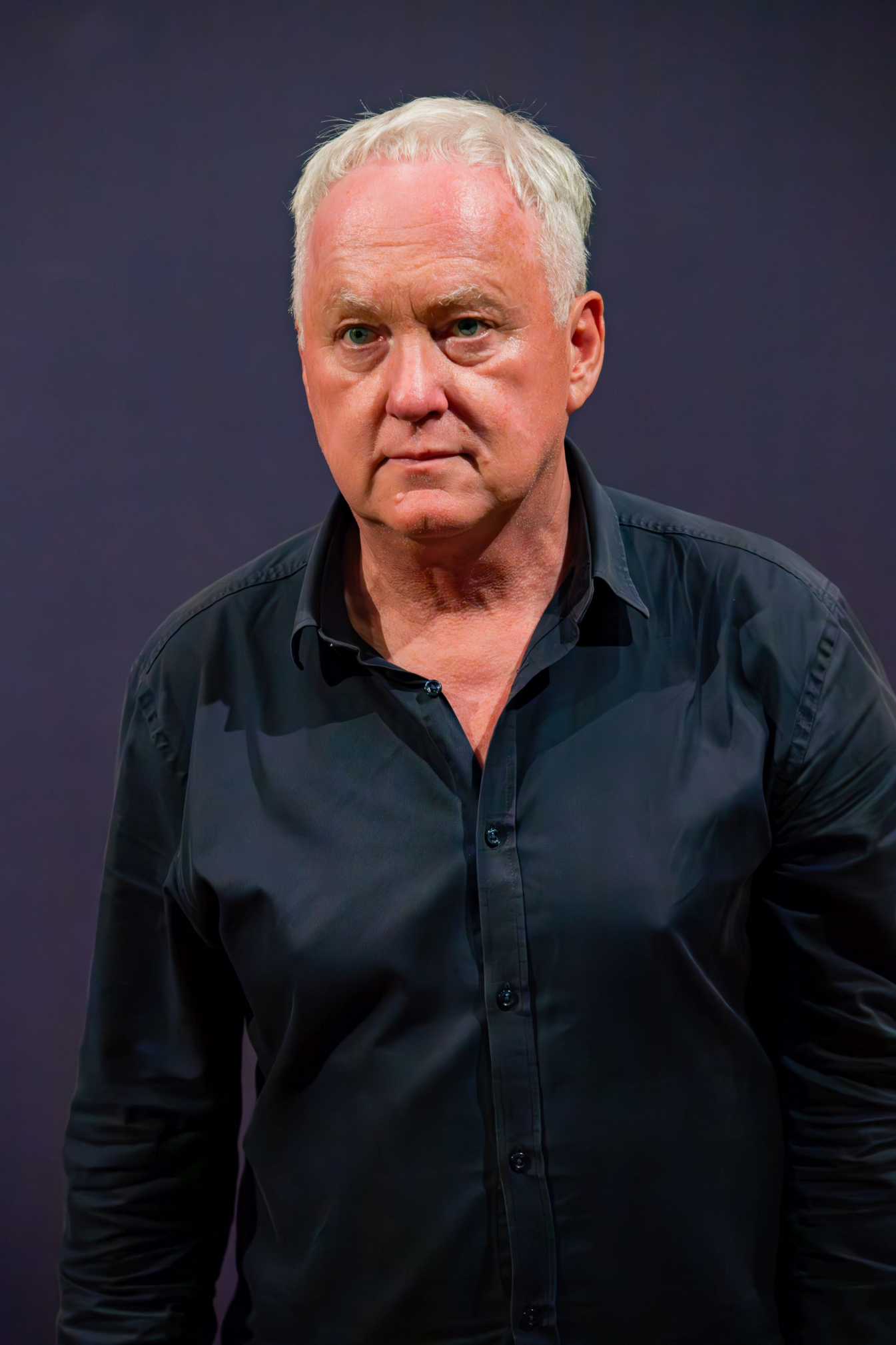
Important themes in his paintings create incredibly beautiful and moving paintings. In a simple, linear form, the artist expresses his admiration of nature – grass swayed by the wind, trees and forests, he contemplates Samogitian crosses or ponders upon the fate of a ground-bent women washing clothes or kneeling – frozen in her prayer.
There are many stories about difficult and important matters in his paintings, referring to the sense and meaning of life. Especially when the artist’s attention concentrates on the relationship between men and women. The stories involving men and women, which we can see in his paintings, are usually complicated and complex. The characters are expressed in black and white forms – seemingly contrasted with each other, but somehow complementary. The power and energy of these contrasts acts like a magnet – they attract each other. They sometimes merge and become one. Simple, almost abstract form, deprived of realistic imaging, allows us to focus on the power of their influence. The choice of colors is not random, as white is often associated with the color possessing such connotations as innocence, gentleness, integrity and delicateness, but also passivity and reception, whereas black is perceived as a strong, distinctive and powerful color, presenting active and dominant attitude. These two shapes often penetrate each other in the paintings – as if they were dancing in a love tangle. These meetings are taken out of a wider context, we can only see characters deprived of every trace of everyday life, limited to emotional gestures, to the essence of their mutual co-existence. The artist’s tale on relations between people clearly confirms his words that love is all that matters. However, he does not only look at people and their relations.
He is the author of beautiful and poetic works devoted to the motif of thread and yarn. As in real life, events, time, fate and all emotions coincide. Yarn is the basic element of fabric, constituting its backbone, running along it. Thread is perpendicular to yarn. Together they constitute the whole, they penetrate each other like threads of our life, they make up fabric. The works poetically image these intertwining relations not only between people but also between them and nature. They convey philosophical reflections in which our life laboriously becomes fabric. We find these forms, closed in straight, crossing lines, very close to our heart. Everyday life intertwines with unusual moments – sometimes very dramatic, sometimes glorious; love interlaces with hate, laughter with tears, joy with sadness, seriousness with jokes.
There are many stories about difficult and important matters in his paintings, referring to the sense and meaning of life. Especially when the artist’s attention concentrates on the relationship between men and women. The stories involving men and women, which we can see in his paintings, are usually complicated and complex. The characters are expressed in black and white forms – seemingly contrasted with each other, but somehow complementary. The power and energy of these contrasts acts like a magnet – they attract each other. They sometimes merge and become one. Simple, almost abstract form, deprived of realistic imaging, allows us to focus on the power of their influence. The choice of colors is not random, as white is often associated with the color possessing such connotations as innocence, gentleness, integrity and delicateness, but also passivity and reception, whereas black is perceived as a strong, distinctive and powerful color, presenting active and dominant attitude. These two shapes often penetrate each other in the paintings – as if they were dancing in a love tangle. These meetings are taken out of a wider context, we can only see characters deprived of every trace of everyday life, limited to emotional gestures, to the essence of their mutual co-existence. The artist’s tale on relations between people clearly confirms his words that love is all that matters. However, he does not only look at people and their relations.
He is the author of beautiful and poetic works devoted to the motif of thread and yarn. As in real life, events, time, fate and all emotions coincide. Yarn is the basic element of fabric, constituting its backbone, running along it. Thread is perpendicular to yarn. Together they constitute the whole, they penetrate each other like threads of our life, they make up fabric. The works poetically image these intertwining relations not only between people but also between them and nature. They convey philosophical reflections in which our life laboriously becomes fabric. We find these forms, closed in straight, crossing lines, very close to our heart. Everyday life intertwines with unusual moments – sometimes very dramatic, sometimes glorious; love interlaces with hate, laughter with tears, joy with sadness, seriousness with jokes.
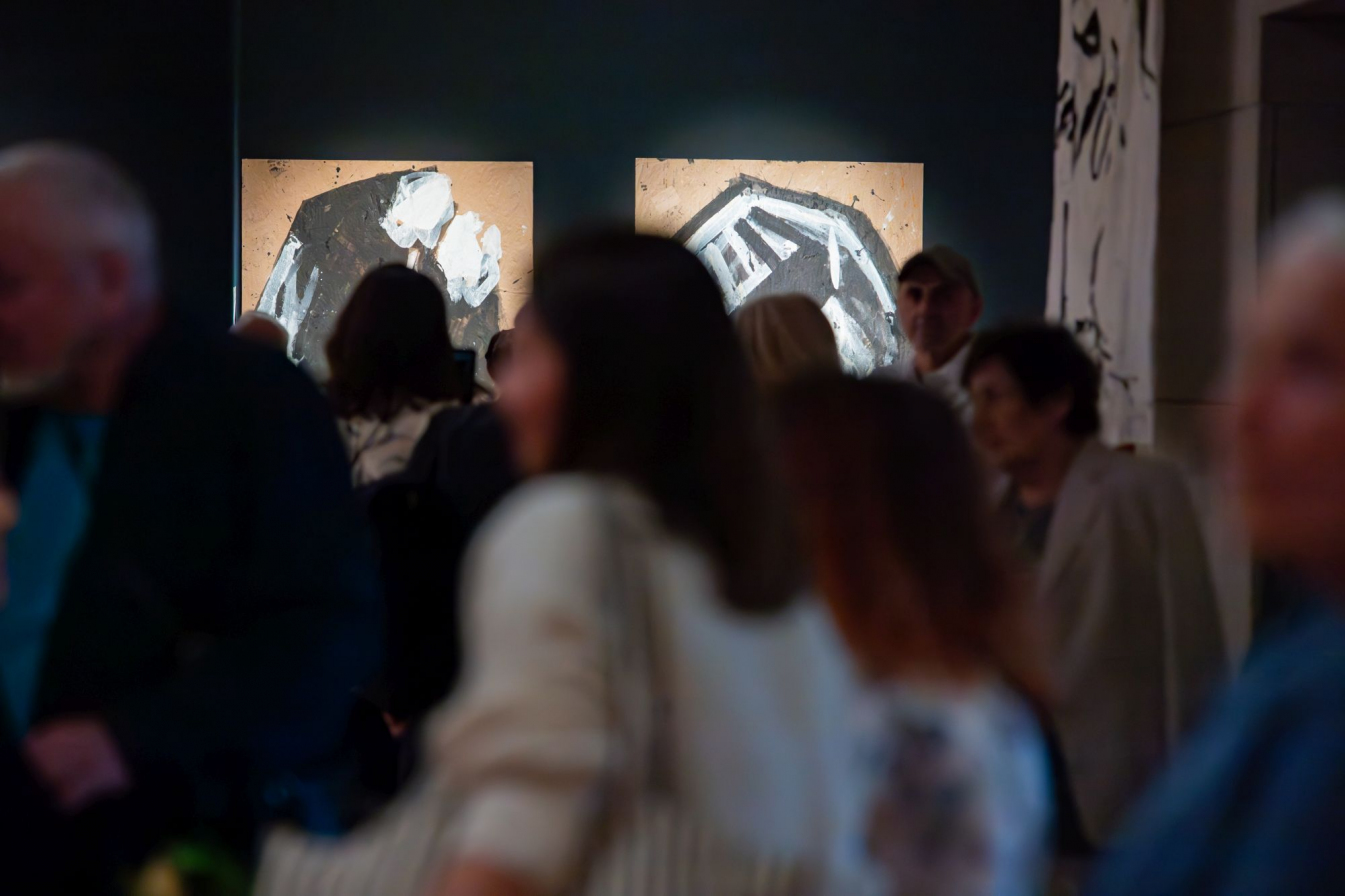
In his paintings, the artist leaves the traces of his own way, his observations and admirations transformed into signs and symbols. This is the art of choosing, as he says, what should be left in the paintings, how not to make it too verbose, how to condense emotions wisely.
In his artistic credo, Piotr Jargusz is incredibly true, authentic and sincere, he does not flatter any tastes, he pursues his own truth and he is wise and serious in his pursuit. His works involve, hypnotize, and force us to consider them deeply. How do we talk about the most important in life; how to talk about looking at stars, at passing clouds? How to describe the swoosh of trees, their power and magic, how to paint grass, its smell and melody? How to summarize in a painting gesture the story of an old woman observed in front of a church?
Sometimes we can see a pitting person in his paintings. We can observe a person deep in his or her thoughts, pondering their fate. A pensive person, just like the roadside figure of pensive Christ – met in many field and forest chapels. One cannot stop thinking then about where we came from, where we are and where we are going.
All the works present a story of a human being, told in a simple code. It is a narrative of the artist and his nearest and dearest, but also of anonymous people whose gestures or actions made him think. They constitute the artist’s sharing of his admiration over an imprint of a boar left in the grass or footprints on the beach, his thrill over a meadow with a mountain view, or the line of the horizon seen on a walk by the sea. The artist stops in places that we often pass by indifferently, focused on our everyday matters. In this way he stops us to look at the world around us, at what is above us and below our feet. He suggests we should look ahead, but also look inside us and ponder.
Beautiful, wise and vivid PAINTING
In his artistic credo, Piotr Jargusz is incredibly true, authentic and sincere, he does not flatter any tastes, he pursues his own truth and he is wise and serious in his pursuit. His works involve, hypnotize, and force us to consider them deeply. How do we talk about the most important in life; how to talk about looking at stars, at passing clouds? How to describe the swoosh of trees, their power and magic, how to paint grass, its smell and melody? How to summarize in a painting gesture the story of an old woman observed in front of a church?
Sometimes we can see a pitting person in his paintings. We can observe a person deep in his or her thoughts, pondering their fate. A pensive person, just like the roadside figure of pensive Christ – met in many field and forest chapels. One cannot stop thinking then about where we came from, where we are and where we are going.
All the works present a story of a human being, told in a simple code. It is a narrative of the artist and his nearest and dearest, but also of anonymous people whose gestures or actions made him think. They constitute the artist’s sharing of his admiration over an imprint of a boar left in the grass or footprints on the beach, his thrill over a meadow with a mountain view, or the line of the horizon seen on a walk by the sea. The artist stops in places that we often pass by indifferently, focused on our everyday matters. In this way he stops us to look at the world around us, at what is above us and below our feet. He suggests we should look ahead, but also look inside us and ponder.
Beautiful, wise and vivid PAINTING
Anna Budzałek
Art Historian
Custodian in Department
of Contemporary Art in
National Museum in Kraków
May 2024
Text included in the catalog “Love is the most important. Street paintings of Piotr Jargusz", 2024
Text included in the catalog “Love is the most important. Street paintings of Piotr Jargusz", 2024








